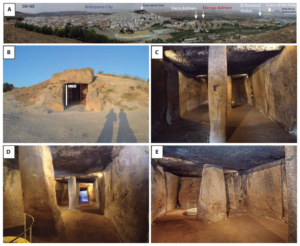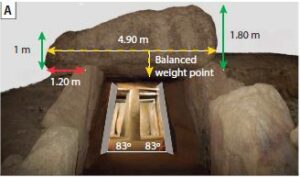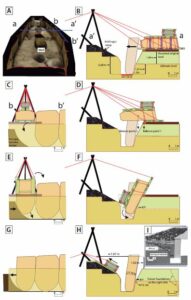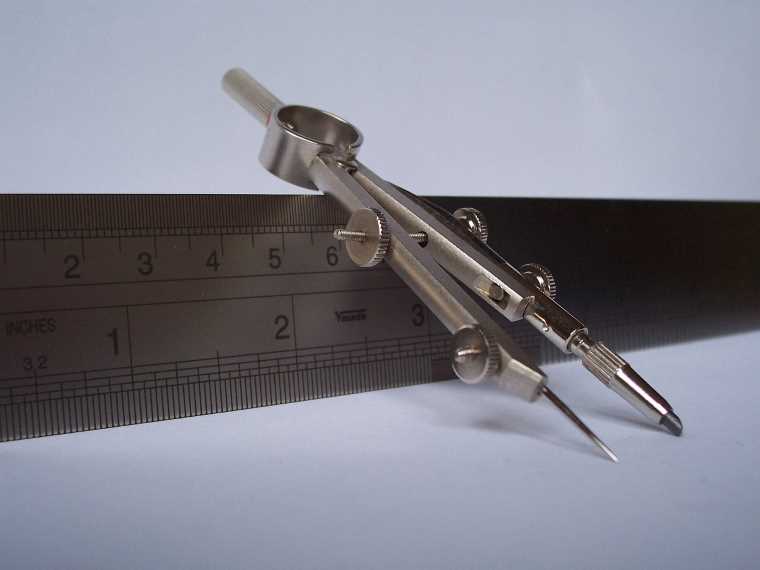A new analysis of the megalithic stone monument Menga (also known as the Dolmen of Menga) in the Iberian Penisula shows that its ancient builders likely understood complex early science concepts, including geometry and friction, thousands of years before Euclid, the Greek scientist and “Father of Geometry,” was born.
“It is impossible to understand how a monument as sophisticated as Menga was built between 3800 and 3600 BCE without resorting to a notion of ‘early science,’ especially considering that, to this date, no precedents have been found in Iberia suggesting a gradual, steady increase in the development of engineering expertise through trial and error,” José Antonio Lozano Rodríguez and colleagues write in their published study.
“Our findings run entirely counter to the idea of ‘primitiveness’ or ‘rudeness’ that for a long time has underpinned both the popular and scientific understanding of Neolithic societies.”
If confirmed, the massive stone monument and the scientific methods seemingly used in its construction could compel archaeologists and anthropologists to redefine the origins of early science. The findings could also help scientists paint a clearer picture of Neolithic societies that built massive stone monuments before the ancient Egyptian Pyramid builders of the 3rd century BCE, which may have been more organized and sophisticated than previously believed.
Early Science Concepts Showed Up Earlier Than Previously Thought
Throughout much of the 20th century, researchers mostly agreed that the various Neolithic societies that popped up around 6,500 years ago lacked the scientific knowledge and sophistication to build monuments like those that began to appear in the ensuing millennia. More recently, discoveries like the ancient stone monument of Gobekli Tepe in Turkey have forced scientists to reevaluate those conclusions, including what aspects of early science these ancient builders may have used.
In March, The Debrief reported on a series of excavations off the coast of Rome in the Mediterranean Ocean that showed Stone Age hunters used advanced maritime technologies to construct their boats and navigate the ocean sometime around 5,000 BCE. Earlier this month, The Debrief also highlighted new findings that showed ancient seafaring people colonized parts of modern-day Indonesia using ‘advanced technology’ over 42,000 years ago.
Now, a team of researchers analyzing several aspects of Menga says its builders appear to have employed various scientific concepts, including geometry, and likely understood the idea of friction.
size and Composition of Capstones Suggest an Understanding of Friction
In the study, published in Science Advances, the researchers examined several critical aspects of the massive megalithic site Menga. With 32 giant stones totaling approximately 1,140 tons, the site features a roof, walls, and pillars. The researchers write, “Its extraordinary dimensions demanded sophisticated design and planning, a large mobilization of labor, and perfectly executed logistics.” Still, they note that it has never been studied by experts from such a diverse group of scientific disciplines.


“Like most early megaliths, Menga has never been analyzed from an interdisciplinary perspective combining archaeological, petrological, and stratigraphic (sedimentological and paleontological) evidence,” they write. “Therefore, the challenges involving its construction have not been evaluated as an engineering problem.”
They first studied the size, weight, and composition of the monument’s capstone #5. At 150 tons, the researchers say this single piece of ancient rock “is the largest stone ever moved in Iberia as part of the megalithic phenomenon and one of the largest in Europe.”
That analysis found that the various capstones used in constructing the monument’s roof, including this massive piece of stone, ranged from soft to moderately soft. To move these huge, delicate stones, the researchers believe the site’s ancient builders must have had at least a rudimentary understanding of friction. Specifically, the team believes “this would have been only workable on a previously made and carefully designed road (or “track-way”) that would minimize friction.”
Still, the team says the most compelling evidence for the understanding and use of early science came from a geometric analysis of the site. Their results show Mega’s builders were more aware of geometry than previously believed.
Scales, Facets, and Wedges Reveal Understanding of Geometry
The first sign that Menga’s builders understood and employed geometry involved the site’s upright stones. “Once inside Menga, it becomes readily apparent that the uprights do not stand perfectly vertically,” they write.


Instead, like the more sophisticated sites built during Euclid’s time, the upright stones at Menga have millimeter-scale slopes. They also “lean sideways against each other,” the researchers note, “with angles of 80°, 86°, and 88°, both on the right and left sides of the dolmen.” This positioning not only gives the construction a slightly trapezoidal shape, which conveys a significant advantage in structural stability, but according to the research team, it is a “key indicator to assess the order in which the stones were placed and, therefore, to infer how the monument was built.”
The team also believes the angular placement of the upright stones resulted from the delicacy of the softer stones used for the site’s roof. Specifically, the team notes that “this clever idea allowed the builders to reduce the width of the capstones, given that the stones were made of soft or moderately soft rocks and not very resistant to traction efforts.”
Another surprising finding that supported the site’s builders’ understanding of geometry came from places where some of the stones meet. According to the press release announcing the study, many of the monument’s walls are “interlocked with one another through lateral facets.” These types of construction techniques were not expected at sites this ancient.
Finally, the team performed a detailed analysis of the upright stones’ placement in the site’s bedrock. According to the release, both the walls and the pillar stones were “wedged into the bedrock.” Although the exact process these ancient builders used is unknown, the team’s study offers a likely scenario requiring a sophisticated understanding of certain geometry concepts, including balance and counterweights.


“The way the stones were placed provides numerous clues concerning the creative genius and early scientific engineering resourcefulness of the architects and engineers who designed and built Menga,” they write. “The fact that they designed deep foundation sockets, in order that, when placed, one-third of the uprights and pillars would stand underground makes very plausible the use of counterweights to place them.”
Findings May Redefine Stereotypes of Neolithic Societies
In the study’s conclusion, the researchers note that Menga shows signs of its builders utilizing and understanding a wide range of scientific concepts. Furthermore, they explain that “the incorporation of advanced knowledge in geology, physics, geometry, and astronomy shows that Menga represents not only a feat of early engineering but also a substantial step in the advancement of human science, reflecting the accumulation of advanced knowledge.”
The authors note that Menga is unique in terms of the builder’s level of technological sophistication compared to other Neolithic sites. They say Göbekli Tepe, for example, used wood and other more basic construction techniques that were less sophisticated than this monument.
“On the basis of the evidence at hand, Menga is one of the first great monumental buildings ever engineered with colossal stones,” they write. “Not only no precedents existed in Iberia for such a monument when Menga was built, but also no comparable monument was later made throughout all of Late Prehistory. Or at least, we have no record left.”
Christopher Plain is a Science Fiction and Fantasy novelist and Head Science Writer at The Debrief. Follow and connect with him on X, learn about his books at plainfiction.com, or email him directly at christopher@thedebrief.org.

